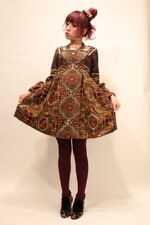Dolly Kei was a short-lived style from Japan in the early 2010s. [1] The style was highly influenced by European history and antique dolls. Fairy tales, Romani culture, and peasants of the Middle Ages are all highly influential to this style. [2][3] Dolly Kei is not nearly as focused on brands as other Japanese styles, though many believe the style was a creation of the brand Grimoire. [3] While this style may still be worn today, it is considered an inactive style due to its incredible drop in popularity. It is rarely seen worn anymore, although its influence can still be seen in other styles. [4]
Dolly Kei is often confused with Cult Party Kei and Mori Girl.
The Name[]
According to an interview with Grimoire, the term "Dolly Kei" was made up by the west to refer to their style, and is not actually used in Japan. It was mistaken from the name "Dolly" or "ドリー" that referred to a line of accessories made by one of Grimoire's creators.
The Grimoire shop staff referred to their style as "antique," "used," or simply "vintage." [5][6] However, the name dolly kei has firmly stuck in the international community, and it is unlikely that the name will ever be replaced with the original Japanese terms worldwide.
Style Basics[]
Dolly Kei does not have strict style guides. There is no set length or silhouette. While layering is very important to the style, it is not necessary for an outfit to be considered Dolly Kei. For an outfit to be considered Dolly Kei, it is important for the outfit to have an 'ethnic' or vintage look. A key part of the style is for the style's historical and cultural influences to be visible. [2][3]
Color Schemes[]
Black and jewel tone colors are very common for Dolly Kei. Any colors that are commonly seen in ethnic patterns and Middle Ages tapestries are typical for the style. Sometimes light and pale colors and white are used in the style, however it is much less common.
Patterns and mixing of weight and textures are often used in the style. Embroidery, tapestry, fur, lace, tassels, and flowers are all popular elements. Items don't necessarily have to flow with one another - clashing items and patterns are actually encouraged.
Accessories[]
Accessories tend to be on the larger side. This style is far from subtle - complex elements are used to draw the eye in. Handmade and vintage items are king - this style prides itself on the more well worn and visibly handmade an item is. Unique and one-of-a-kind items are highly encouraged.
Some may argue that accessories are the most important part of the style. There is no limit or requirement to how many accessories are needed for the style, but it is popular to wear many different accessories at once. Dolly Kei almost has a cluttered look to it at times in some outfits. The more elaborate and fancy the accessories are, the better.
Hairstyles[]
Hairstyles are natural and simple. Wavy hair, braids, and simple updos are commonly seen. Hair colors tend to stay on the darker side of natural colors - black, brown and dark shades of red.
Makeup[]
Makeup is almost always natural. Thick lashes and heavy blush is common, but not necessary.
Shoes[]
There is no real restriction or limitations when it comes to footwear, but simple and vintage looking shoes are more commonly worn with the style. Victorian-style shoes and mary jane shoes are popular for the style. Handmade items are not limited to just clothing and accessories - sometimes handmade shoes are worn as well.
Modern Dolly Kei[]
The famous brand Grimoire is still active to this day. However, the style is trying to target those in their 30s and 40s as their loyal customers have grown up. Because of this, their style is changing too, taking a more mainstream twist. Whether or not this new style should be considered under the same label as the original style is unclear. [7]
Brands & Shops[]
Gallery[]
External Links[]
- ↑ Information determined from the creation of the store Grimoire
- ↑ 2.0 2.1 "What is Dolly Kei?" Strange Girl. 2012. Retrieved August 26, 2020 from https://web.archive.org/web/20120229110629/http://strangegirlblog.blogspot.com/p/what-is-dolly-kei.html
- ↑ 3.0 3.1 3.2 "Grimoire Shibuya - Japanese Dolly-kei & Vintage Fashion Wonderland." Tokyo Fashion. March 13, 2010. Retrieved August 26, 2020 from http://tokyofashion.com/grimoire-shibuya-japanese-dolly-kei-vintage-fashion-wonderland/
- ↑ Information determined from a lack of resources and photographs of Dolly Kei in Japan and abroad
- ↑ [Interview] What is the reason for the breakthrough of "Grimoire" by Naoaki Tobe and Hitomi Nomura? (translated). January 04, 2014. Retrieved August 29, 2020 from https://www.fashionsnap.com/article/grimoire-tobe-nomura/
- ↑ Hitomi Nomura. "About Vintage." Hitomi Nomura Official Blog. May 15, 2014. Retrieved September 13, 2020 from https://ameblo.jp/asbs-hitomi/entry-11851426469.html
- ↑ Samuel Thomas. "Tokyo fashion faces some backstage changes." Japan Times. July 9, 2016. Retrieved September 14, 2020 from https://www.japantimes.co.jp/life/2016/07/09/style/tokyo-fashion-faces-backstage-changes/












